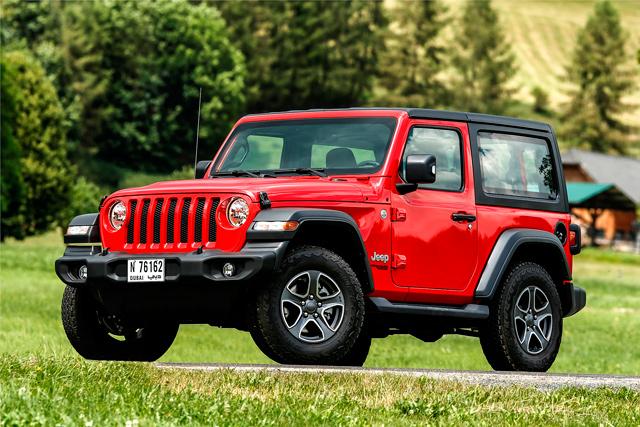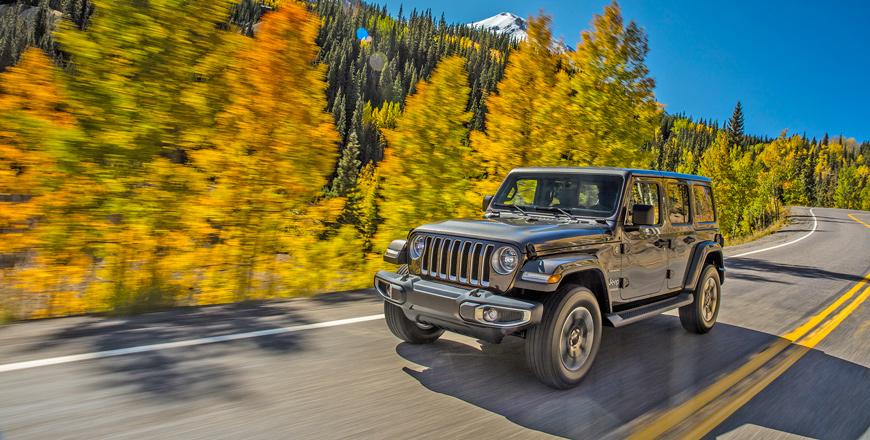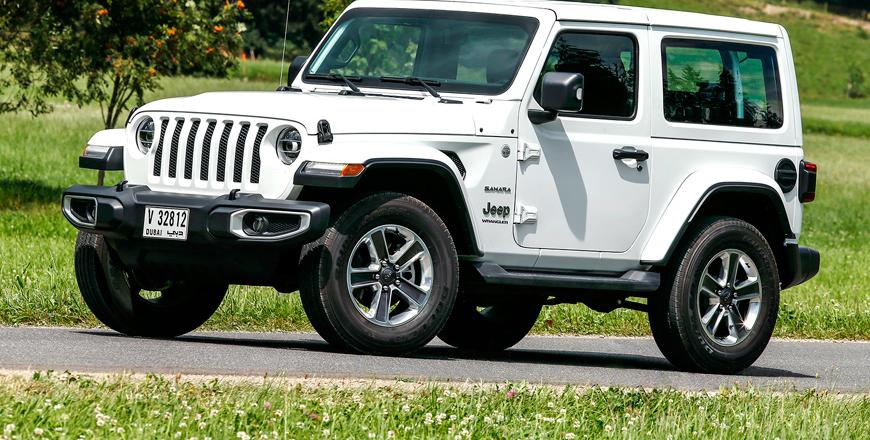You are here
Jeep Wrangler Sport 2-door: Authenticity and ability
By Ghaith Madadha - Jul 23,2018 - Last updated at Jul 23,2018

Photo courtesy of Jeep
The latest iteration of that most iconic of off-road vehicles, the all-new “JL” generation Jeep Wrangler is the most sophisticated and refined yet, but does it without diverging from its core DNA or actual and tangible authenticity.
A direct descendent of the US Army’s 1941 Willys Jeep, the new Wrangler was launched just last week for European and Middle East markets in two body styles and three trim levels. While retaining its traditional aesthetic and underlying mechanical design, the new Wrangler, however, adds improved practicality, efficiency, daily usability, driving refinement and infotainment, convenience and driver assistance technology.
Recognisably rugged
A design evolution rather than fashion-driven retro ‘inspired’ machine, the new Wrangler’s hallmark Jeep styling cues are immediately recognisable and include its seven-slot grille, tapered bonnet, large wheel-arches and boxy upright body, which makes it more practical, utilitarian and easier to manoeuvre. Slightly larger yet with restrained weight owing to greater use of lightweight body components, the new Wrangler’s grille and windshield are slightly more swept back for improved aerodynamic efficiency and refinement. Meanwhile its round headlights now slightly intrude up on the outer grille slots as a styling nod to long-running 1944-86 “CJ” generation Jeeps.
Best looking in two-door versions as driven, the JL-generation Wrangler’s new square rear lights lend a more contemporary aesthetic, while its profile is instantly recognisable as a Jeep, with short front overhang, and an upright and rearwards cabin sitting on a short wheelbase. Built on a rugged traditional body-on-chassis frame and featuring integrated rollover bars, the Wrangler uniquely offers full open air off-road motoring, and is available with three roof options, including electrically retractable Sky One-Touch soft-top or fully removable Zipperless Premium Sunrider soft-top and removable three piece Freedom Top hard-top options.
Seamless, smooth
and eager
Available only with the range-topping naturally-aspirated 3.6-litre “Pentastar” V6 engine and slick, smooth and snappy 8-speed gearbox combo regionally, the Wrangler develops 281BHP at a relatively high-revving 6400rpm and 256lb/ft torque at 4100rpm. Eager from standstill, urgent at top end and progressive in delivery, yet, versatile and flexible in mid-range, the Wrangler’s Pentastar engine is seamlessly smooth and consistent, and with responsive throttle control, allows one to dial in exact power increments for more precise on- and off-road driving. Capable of 177km/h and brisk through 0-100km/h, Jeep, however, does not quote an official acceleration time for the 3.6-litre Wrangler.
Driving all four wheels through a standard automatic gearbox — with no 6-speed manual gearbox option regionally as in the US market — the entry-level Wrangler’s Selec-Trac four-wheel-drive system offers one the choice three high ratio driving modes for road driving and less demanding off-road routes and low range 4x4 for more demanding off-road driving. These include a rear-drive, part-time four-wheel-drive and four-wheel-drive “auto” modes, the latter of which sends power to the rear in normal driving conditions, but automatically reallocates more power to the front to maintain traction and grip as necessary.
Manoeuvrable mountain goat
In its element off-road, the Wrangler Sport’s lever actuated low range four-wheel-drive mode allows one to access high power and torque at crawling pace to climb steep inclines, drive through deep ruts and for towing over loose surfaces.
The Wrangler also benefits from rugged ladder-frame construction and live front and rear axles, with coil spring five-link suspension providing generous wheel travel over difficult terrain. Sitting 235mm off the ground, and with a short 2459mm wheelbase, the two-door Wrangler benefits from particularly generous ground clearance and break-over angles, in addition to excellent approach and departure angles for deep ruts, rocks, inclines and uneven surfaces.
Hugely capable off-road with its 2.72: low ratio reduction gearing, the Wrangler Sport is also offered with an optional limited slip differential for off-road traction, and on-road handling agility. However, during test drive on demanding Austrian off-road routes in the Alps, the Wrangler Sport got by easily, even without the locking differentials offered on the yet more off-road capable Wrangler Rubicon model. Confident, brisk and eager on dirt roads and badly paved tarmac, the Wrangler’s small size and short wheelbase make it manoeuvrable even on the narrowest lanes, while tall tyre sidewalls ensure comfort and supple absorptions of imperfect textures.
Confident comfort
Engineered for improved on-road driving, the latest Wrangler’s refinement, agility, smoothness and steering precision are as good as it gets for a dedicated off-roader with a ladder frame chassis and with front and rear live axles. Ultimately not as road-biased as other Jeep offerings with monocoque construction and independent suspension, the new Wrangler does, however, drive well, with tidy turn-in, nimble cornering and a good measure of road comfort and insulation from harshness, noise and vibration. Meanwhile at speed, it is unexpectedly confident, stable and settled for so short and tall a vehicle.
Tall and upright with alert seating and a now lower waistline — contrary to the current trend for higher waistlines, the two-door Wrangler offers better road visibility than most SUVs, and allows one to accurately place it on — and off-road. Seating is supportive and comfortable, with an upright and ergonomic driving position. Detaching the Wrangler’s doors and roof, and folding down its windshield has also been made easier, while inside design and material used are noticeably improved on its predecessor. High equipment levels include a Uconnect infotainment system and safety features like blind spot and rear cross-path detection.
TECHNICAL SPECIFICATIONS
Engine: 3.6-litre, in-line, V6-cylinders
Bore x Stroke: 96 x 83mm
Compression ratio: 11.3:1
Valve-train: DOHC, 24-valve, variable timing
Gearbox: 8-speed automatic, four-wheel-drive, low ratio transfer
Gear ratios: 1st 4.714:1; 2nd 3.143:1; 3rd 2.106:1; 4th 1.667:1; 5th 1.285:1; 6th 1:1; 7th 0.839:1; 8th 0.667:1
Reverse/final drive: 3.295:1/4.45:1
Low ratio transfer/crawl ratios: 2.72:1/44.2:1
Power, BHP (PS) [kW]: 281 (285) [209] @6400rpm
Specific power: 77.9BHP/litre
Power-to-weight: 148.3BHP/tonne
Torque, lb/ft (Nm): 256 (347) @4,100rpm
Specific torque: 96.2Nm/litre
Torque-to-weight: 183.2Nm/tonne
Top speed: 177km/h
Fuel consumption, urban/extra-urban/combined; 13-/7.7-/9.6-litres/100km
CO2 emissions, combined: 223g/km
Fuel capacity: 66-litres
Length: 4,334mm
Width: 1,894mm
Height: 1,858mm
Wheelbase: 2,459mm
Approach/break-over/departure angles: 35.2°/23.9°/29.2°
Kerb weight: 1,894kg
Weight distribution, F/R; 51 per cent/49 per cent
Payload: 494kg
Towing maximum: 1,500kg
Steering: Power-assisted rack & pinion
Steering ratio: 16.14:1
Lock-to-lock: 3.68-turns
Turning circle: 10.36-metres
Suspension: Five-link, solid axles, coil springs, anti-roll bars
Brakes, F/R: Ventilated disc, 330 x 24mm/disc, 328 x 12mm
Brake callipers, F/R: twin-/single-piston
Tyres: 245/75R17
Related Articles
The more sociable version of the Jeep Wrangler, the longer four-door model is a more spacious and family-friendly way to enjoy the most icon
The range-topping and off-road oriented version of what is already one of the best off-road vehicles money can buy, the Jeep Wrangler Rubico
A direct descendent of the celebrated and viscerally iconic 1941 Willys Jeep, the latest “JL” generation Jeep Wrangler is steeped in traditi














